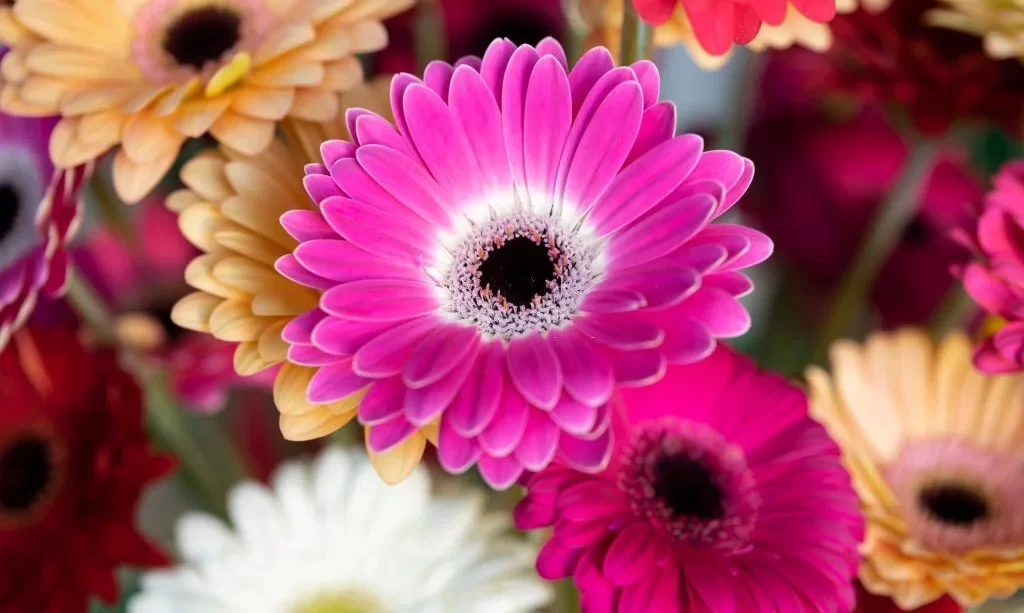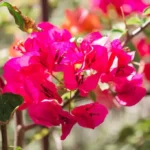Gerbera daisies, with their enchanting array of colors and captivating, daisy-like blooms, have secured a special place in the hearts of gardeners and flower enthusiasts alike. These cheerful and vibrant flowers, often referred to simply as “Gerberas,” are renowned for their striking appearance and enduring popularity as cut flowers and garden ornamentals. As gardeners nurture Gerbera daisies in their outdoor spaces or indoor gardens, a common query emerges: Do Gerbera daisies naturally multiply? In this exploration, we will delve into the world of Gerbera daisies, their natural tendencies, and the methods through which they can be multiplied to bring forth even more of their radiant beauty.
- Sunlight: Partial Shade
- Soil Type: Peat, Sand
- USDA Hardiness Zone (°F): 9 (20 to 30 °F)
- Watering: Medium
Gerbera Daisy Overview
Before we embark on the journey of understanding Gerbera multiplication, let us first acquaint ourselves with the captivating charm and distinctive traits that define Gerbera daisies:
Gerbera daisies belong to the genus Gerbera, with the most commonly cultivated species being Gerbera jamesonii. Native to the lush landscapes of South Africa, Gerbera daisies are celebrated for their eye-catching blossoms. These flowers typically feature large, colorful petals that can be found in a spectrum of hues, including vibrant reds, sunny yellows, and soft pastels. What truly sets Gerbera daisies apart is their prominent dark center, known as the capitulum or disc, which adds depth and contrast to their blooms.
These perennial beauties are known for their long-lasting cut flowers, making them a favorite choice for floral arrangements and bouquets. However, their appeal extends beyond the vase, as they also thrive as potted plants, garden additions, or as colorful accents in mixed flower beds. Understanding the nature of Gerbera daisies and their unique attributes sets the stage for exploring their potential for multiplication and propagation.
Natural Multiplication of Gerbera Daisies
Gerbera daisies possess the innate ability to multiply naturally, primarily through two methods often observed in their wild habitat:
- Seed Production: Gerbera daisies produce seeds as part of their reproductive cycle. These seeds are often dispersed by wind or carried by animals, allowing them to settle and germinate in new locations. In the wild, this method enables Gerbera daisies to colonize different areas over time.
- Offsets (Daughter Plants): Gerbera daisies have a unique growth habit that involves the development of offsets or daughter plants around the base of the parent plant. These offsets are essentially miniature versions of the parent plant, complete with roots and stems. Over time, these offsets can grow into mature plants, effectively multiplying the Gerbera population.
While these natural multiplication methods are evident in the wild, gardeners often take a more controlled approach to Gerbera propagation, especially when they desire specific colors or varieties.
Propagating Gerbera Daisies
Gardeners and horticulturists have developed various methods for propagating Gerbera daisies in a more controlled manner, allowing them to expand their Gerbera collections or rejuvenate existing plants. Some of the primary methods of Gerbera propagation include:
- Division: Dividing mature Gerbera plants is a common propagation method. It involves carefully separating the offsets or daughter plants from the parent plant and replanting them in suitable locations. This method is often used to rejuvenate older Gerbera plants and create new individuals.
- Seed Sowing: Growing Gerbera daisies from seeds is another propagation method. Gerbera seeds can be collected from mature flowers or purchased from seed suppliers. Sowing seeds indoors or directly in the garden provides an opportunity to cultivate new Gerbera plants with potentially unique characteristics.
- Tissue Culture: Tissue culture is a more advanced method used by professional growers and horticulturists. It involves propagating Gerbera daisies from small pieces of tissue in a controlled laboratory environment. This method allows for the rapid multiplication of Gerberas while maintaining genetic purity.
Each propagation method offers its own set of advantages and challenges. Gardeners can choose the method that best suits their needs and preferences, whether it’s creating new Gerbera plants from offsets, experimenting with seeds, or exploring advanced techniques like tissue culture. Understanding these methods empowers gardeners to enjoy the beauty of Gerbera daisies while exploring the art of propagation.
Factors Affecting Gerbera Multiplication
The successful multiplication of Gerbera daisies can be influenced by a variety of factors, and gardeners should be mindful of these elements:
- Climate and Growing Conditions: The local climate and growing conditions can significantly impact the success of Gerbera multiplication. Ideal conditions include moderate temperatures, well-drained soil, and adequate sunlight.
- Gerbera Variety: Different Gerbera varieties may have varying propensities for multiplication. Some may produce more offsets than others, while certain cultivars may be particularly prolific with seeds.
- Proper Care: Providing proper care, including regular watering, appropriate fertilization, and protection from pests and diseases, is essential for healthy Gerbera plants that are more likely to multiply successfully.
- Timing: Timing is crucial when it comes to Gerbera multiplication. Division and transplanting are often best performed during the plant’s dormant period or in early spring when new growth begins.
- 🌿 FLOWER POWER PLANT FOOD – Easily strengthen, enhance and nourish your indoor/outdoor flower planters and baskets with Hydrabloom flower basket edition flower fertilizer. This all-purpose flower plant food is specifically formulated for any flower basket, indoor/outdoor garden, hydroponics and soil.
- 🌿 NUTRIENT-RICH FORMULA – With a balanced combination of macronutrients, micronutrients and kelp extracts, this flower basket liquid plant fertilizer boosts bioavailability for optimal plant health.
- 🌿 PROMOTES FAST & VIBRANT GROWTH – See the difference in your plants after just one use, providing lush blooms, fuller plants, vibrant flowering, and rapid new growth. Perfect for full-bloom planter arrangements, hanging baskets, repotting, perennial gardens, and much more!
- 🌿IDEAL FOR ALL FLOWERING PLANTS – This special flower basket edition of Hydrabloom is ideal for Petunias, Geraniums, Impatiens, Lantana, Pansies, & even Strawberry baskets. Perfect option for greenhouse floral baskets, outdoor & indoor floral arrangements and gardens.
- 🌿 CRAFTED IN SMALL BATCHES IN CANADA – Handcrafted in small batches by experts using 40+ years of experience, our all-purpose flower plant fertilizer is combined with only the top quality ingredients. Made with optimal flower plant health biochemistry requirements in mind.
Encouraging Gerbera Daisy Multiplication
For gardeners looking to encourage Gerbera multiplication, there are several strategies to consider:
- Pruning and Division: Regularly inspect Gerbera plants for offsets (daughter plants) that have formed around the base of the parent plant. Carefully separate these offsets from the parent and transplant them to new locations in the garden to foster multiplication.
- Collecting Seeds: If you wish to experiment with Gerbera seeds, collect mature seeds from existing flowers. Sow them in a suitable seed-starting mix or directly in the garden. Keep the soil consistently moist until germination occurs.
- Provide Optimal Care: Ensure that your Gerbera plants receive optimal care. This includes providing them with well-draining soil, appropriate watering, and protection from extreme weather conditions.
- Fertilize Wisely: Use a balanced, slow-release fertilizer to nourish Gerbera plants, but avoid over-fertilization, which can lead to excessive foliage growth at the expense of flower production.
Conclusion and Key Takeaways
In conclusion, Gerbera daisies, with their captivating colors and striking blossoms, have the potential to multiply both naturally and through controlled propagation methods. Understanding the factors that influence Gerbera multiplication, such as climate, variety, care, and timing, empowers gardeners to create flourishing Gerbera populations in their gardens.
Key takeaways from this exploration include an appreciation for Gerbera daisies’ natural tendencies to produce offsets and seeds, as well as an awareness of the methods gardeners can employ to encourage multiplication. Whether you choose to divide and transplant offsets, experiment with seeds, or explore advanced propagation techniques, the world of Gerbera propagation opens up exciting possibilities for expanding your Gerbera collection and enjoying the beauty of these beloved flowers.
Ultimately, the art of Gerbera multiplication adds a layer of fascination and creativity to gardening, allowing enthusiasts to witness the enduring charm of Gerbera daisies in all their vibrant glory.





